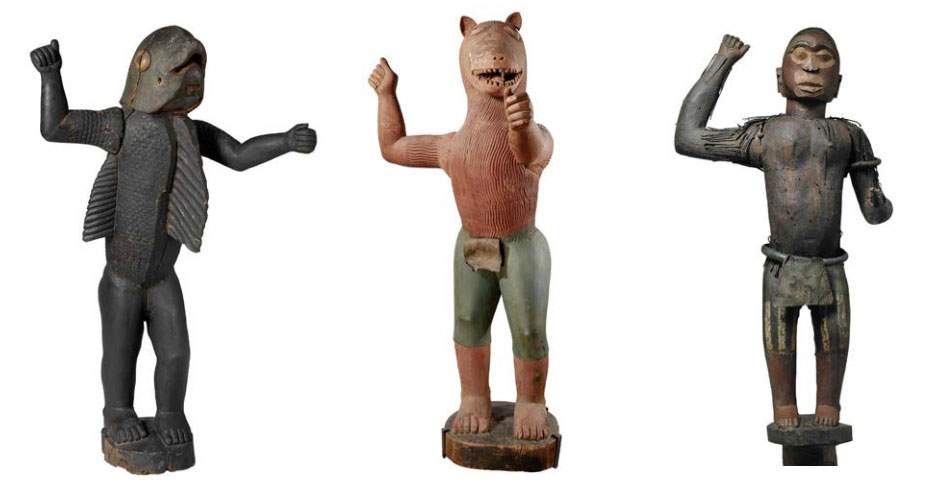Five days to see 26 works on display before they return to their country of origin. It is happening in Paris, at the Musée du Quai Branly, where 26 objects that France will return to Benin are being shown to the public from Oct. 26-31. These are pieces of the royal treasures of Abomey, which became part of the French national collections 130 years ago: they were taken by force during the colonization wars. As a result of an agreement between the two countries, a law was voted and enacted by France in December 2020 providing for the final transfer of ownership of the works to the Republic of Benin. The exhibition, conceived together with the Beninese authorities, offers the public the opportunity to admire these pieces before their departure, but also to understand and measure the scope of the restitution process, to appreciate the need for clarity and rigor that the Musée du quai Branly points to as the value that guides its relationship with the collections, in the name of historical accuracy, the enrichment of knowledge and its wider dissemination.
The arrival of these works in France dates back to the time of the colonization war that pitted the kingdom of Danhomé against France between 1890 and 1894. A column led by Colonel Dodds, on Nov. 17, 1892, entered the capital city of Abomey, where French troops occupied the palace of King Béhanzin, who had left it in the meantime, and removed several objects as spoils of war. Colonel Dodds (who later became a general) decided, between 1893 and 1895, to donate 26 of them to the Musée d’Ethnographie du Trocadéro: these are the objects that later became part of the collection of the Musée du Quai Branly. Benin became independent in 1960 (under the name of Dahomey), and it was not until 2005 that talk of returning the works began, when Christiane Taubira, a Guyanese congresswoman, asked the French government to return the works to their homelands. Instead, the official request by the government of Benin dates back to 2016: initially France rejected it in the name of the principle of inalienability of national heritage, but then changed its mind following the famous report by Felwine Sarr and Bénédicte Savoy on the return of African heritage. This brings us to December 2020, when the law allowing for an exception to the principle of inalienability is enacted. In Benin, the works will become part of the Musée de Ouidah, which tells the story of the Danhomè kingdom. France has signed a program of support and cooperation to enhance the works.
The exhibition tells the origins and history of these objects, which specifically are: three bochio statues made of wood and metal (these were statues that served as amulets to protect the army), all from the second half of the 19th century; six asẽn, portable altars fixed on rods that served to commemorate a deceased person (all from the 19th century); a katakiè ceremonial chair (it was used for royal or cultic ceremonies) from the 19th century; the throne of King Ghézo, from the early 19th century; the throne of King Glèlè, made between 1858 and 1889; a worked vessel, with lid, from the 19th century; a sculpture-decorated royal stool, made of wood, from the late 18th or early 19th century; the doors of King Glèlè’s palace, made of wood, pigments and iron in the 1880s; three kpo, or axe-shaped scepters (used by the king but also by high dignitaries and priests of voodoo cults) from the late 19th century; a weaving spindle from the 19th century; a small warper from the 19th century; and a tunic, a pair of pants and a soldier’s bag, from the late 19th century.
The most interesting objects are the three bochios of kings Ghézo, Glèlè and Béhanzin, which were also the subject of a scientific study aimed at understanding their internal constitution but also their function. They are life-size statues attributed to the sculptor Sossa Dede, the author of ritual statues and wooden works in the late 19th century. The study was conducted by the Research and Education Department and the Heritage and Collections Department of the Musée du Quai Branly, in the persons of Philippe Charlier and Christophe Moulherat. A complete radiographic examination was conducted to study the materials (ancient restorations were also found in the statue of Béhanzin).
To learn more, you can visit the Musée du Quai Branly website.
Pictured are the three bochio statues: the fish man of King Béhanzin, the lion man of King Glèlè, and the bird man of King Ghézo.
 |
| Paris, Musée du Quai Branly displays 26 objects before returning them to Benin |
Warning: the translation into English of the original Italian article was created using automatic tools. We undertake to review all articles, but we do not guarantee the total absence of inaccuracies in the translation due to the program. You can find the original by clicking on the ITA button. If you find any mistake,please contact us.